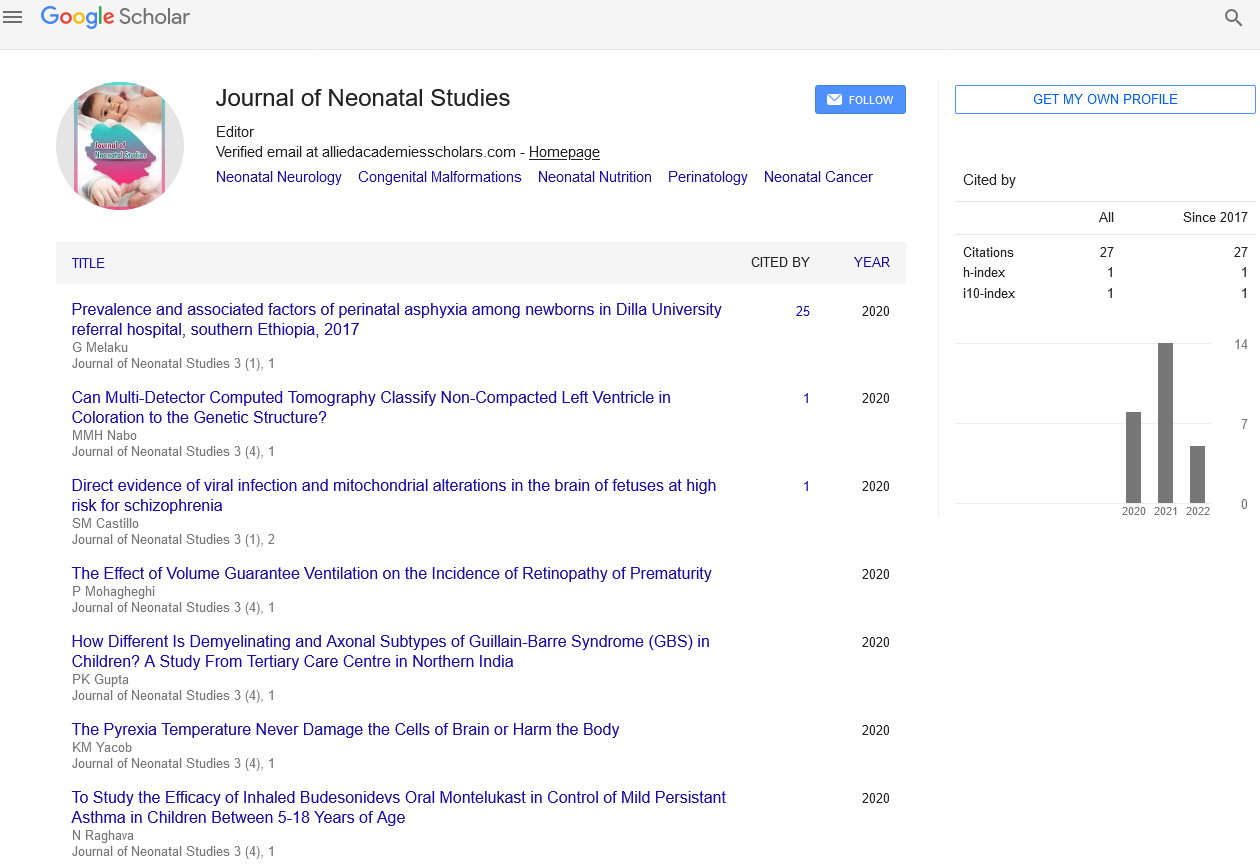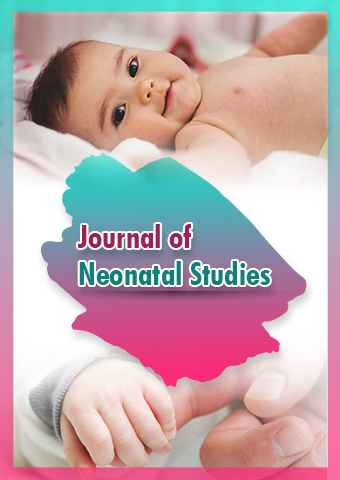Opinion Article - Journal of Neonatal Studies (2024) Volume 7, Issue 6
Diaper Rash in Neonates: Causes, Prevention, and Treatment
- Corresponding Author:
- Ronald Jason
Department of Dermatology, Cornell University, USA
E-mail: ronaldjason1995@med.cornell.edu
Received: 04-Nov-2024, Manuscript No. JNS-24-150539; Editor assigned: 06-Nov-2024, PreQC No. JNS-24-150539 (PQ); Reviewed: 20-Nov-2024, QC No. JNS-24-150539; Revised: 24-Dec-2024, Manuscript No. JNS-24-150539 (R); Published: 31-Dec-2024, DOI: 10.37532/JNS.2024.7(6).294-296
Introduction
Diaper rash, also known as diaper dermatitis, is a common condition that affects the delicate skin of newborns and infants. It is characterized by red, irritated skin in the diaper area and can cause discomfort and distress for both the baby and the parents. Understanding the causes, prevention strategies, and effective treatments for diaper rash is essential for promoting the health and well-being of neonates. This article explores the various aspects of diaper rash, including its causes, prevention, and treatment.
Description
Causes of diaper rash
Diaper rash can result from a combination of factors that irritate the baby’s sensitive skin. Some of the common causes include:
Prolonged exposure to wetness: Diapers trap moisture against the baby’s skin, creating a warm and humid environment. Prolonged exposure to urine and feces can break down the skin’s natural barrier, leading to irritation and rash.
Friction: The constant rubbing of the diaper against the baby’s skin can cause friction, leading to chafing and irritation. This is especially common in areas where the diaper fits tightly, such as the thighs and waist.
Chemical irritants: Ingredients in disposable diapers, wipes, and diaper creams, such as fragrances, alcohol, and preservatives, can irritate the baby’s skin. Laundry detergents and fabric softeners used on cloth diapers can also cause irritation.
Infection: Bacterial and fungal infections can develop in the diaper area, contributing to diaper rash. Candida (yeast) infections are particularly common, as yeast thrives in warm, moist environments.
Antibiotic use: Antibiotics can disrupt the natural balance of bacteria on the baby’s skin and in the gastrointestinal tract, making the baby more susceptible to infections and diaper rash.
Prevention of diaper rash
Preventing diaper rash involves maintaining good hygiene and taking proactive measures to protect the baby’s skin. Here are some effective prevention strategies:
Frequent diaper changes: Change the baby’s diaper as soon as it becomes wet or soiled. Frequent diaper changes reduce the baby’s exposure to moisture and irritants, helping to prevent diaper rash.
Gentle cleansing: Clean the diaper area thoroughly with mild, fragrance-free wipes or a soft cloth and warm water. Avoid using harsh soaps and alcohol-based wipes, as they can irritate the baby’s skin.
Drying the skin: After cleaning the diaper area, gently pat the skin dry with a soft towel. Allow the skin to air dry for a few minutes before putting on a new diaper to ensure that the area is completely dry.
Diaper-free time: Allow the baby to spend some time without a diaper each day to let the skin breathe and reduce moisture buildup. Place the baby on a soft, absorbent surface, such as a towel or cloth, to catch any accidents.
Treatment of diaper rash
If diaper rash does occur, prompt and effective treatment can help alleviate the baby’s discomfort and promote healing. Here are some recommended treatment approaches:
Frequent diaper changes: Continue to change the baby’s diaper frequently to keep the diaper area clean and dry. This is especially important when the baby has a diaper rash.
Gentle cleansing: Clean the diaper area gently with warm water and a mild, fragrance-free cleanser. Avoid using wipes that contain alcohol or fragrances, as they can further irritate the skin.
Antifungal creams: If the diaper rash is caused by a yeast infection, an over-the-counter antifungal cream, such as clotrimazole or miconazole, may be recommended by a healthcare provider. Apply the antifungal cream as directed, usually before applying a barrier cream.
Topical steroids: For severe or persistent diaper rash, a healthcare provider may prescribe a mild topical steroid cream to reduce inflammation and promote healing. Use steroid creams only as directed by a healthcare provider, as overuse can cause skin thinning.
Air exposure: Allow the baby’s skin to air out as much as possible by giving the baby diaper-free time throughout the day. This helps to reduce moisture and promote healing.
When to seek medical attention
While most cases of diaper rash can be managed at home with proper care and treatment, there are situations where medical attention may be necessary:
Severe rash: If the diaper rash is severe, with extensive redness, swelling, or open sores, it is important to seek medical advice.
Persistent rash: If the diaper rash does not improve with home treatment within a few days or continues to worsen, consult a healthcare provider.
Yeast infection: If the diaper rash is suspected to be caused by a yeast infection, a healthcare provider can recommend appropriate antifungal treatment.
Case studies and success stories
Several case studies highlight the effectiveness of proper diaper rash prevention and treatment:
Case study 1: A 2-month-old infant developed a moderate diaper rash after being introduced to a new brand of diapers. The parents implemented frequent diaper changes, gentle cleansing, and the use of a zinc oxide-based barrier cream. The rash improved significantly within a few days, and the parents switched to a different brand of diapers to prevent recurrence.
Case study 2: A 6-month-old baby with a persistent diaper rash was found to have a yeast infection. The healthcare provider recommended an antifungal cream and advised the parents to continue using a barrier cream. The baby’s rash resolved within a week, and the parents were instructed to maintain good diaper hygiene to prevent future infections.
Case study 3: A preterm infant in the Neonatal Intensive Care Unit (NICU) developed severe diaper rash due to prolonged exposure to moisture and frequent diaper changes. The NICU team implemented a care plan that included more frequent diaper changes, gentle cleansing, and the use of a specialized barrier ointment. The infant’s rash gradually improved, and the care plan was continued until the skin was fully healed.
Research and future directions
Ongoing research in neonatal dermatology continues to explore new approaches to preventing and treating diaper rash. Some areas of focus include:
Innovative barrier creams: Developing new formulations of barrier creams that provide better protection and healing properties while being gentle on the baby’s skin.
Probiotics and prebiotics: Investigating the use of probiotics and prebiotics to support healthy skin microbiota and reduce the risk of diaper rash and infections.
Advanced diaper materials: Researching new materials and technologies for disposable and cloth diapers that offer improved absorbency, breathability, and comfort.
Parental education programs: Implementing comprehensive educational programs for parents and caregivers to promote best practices in diaper hygiene and skin care.
Conclusion
Diaper rash is a common condition that can cause discomfort and distress for neonates. By understanding the causes, implementing preventive measures, and providing effective treatment, parents and healthcare providers can ensure the health and well-being of infants. Proper diaper hygiene, frequent diaper changes, and the use of barrier creams are essential strategies for preventing and managing diaper rash. Ongoing research and advancements in neonatal dermatology continue to enhance our ability to care for the delicate skin of newborns, ultimately promoting their overall health and happiness.

